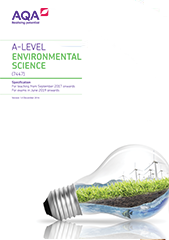3.7 Research methods
Research methods include details of the methods used to investigate a wide range of environmental issues. It is not expected that students will have first hand experience of all of these although, where this is possible, it will enhance their learning experience. The required practical skills are detailed in Appendix A: Working scientifically and opportunities for developing these skills are signposted throughout the subject content.
Students must understand the general principles of scientific methodology and be able to apply these to a wide range of environmental situations and techniques.
Preliminary studies may be used to ensure the study will produce representative data.
Practical activities should be carried out with consideration of their environmental impacts and how these can be minimised.
Students must undertake experimental and investigative activities, including appropriate risk management, in a range of environmental contexts. They must also know how to safely and correctly use a range of practical equipment and materials.
Students must carry out practical activities using the best contemporary practices for risk assessment and safe working in the laboratory and during fieldwork.
Scientific methodologies
|
Content |
Additional information |
|---|---|
|
Sample location: random sampling |
Importance of the avoidance of bias. |
|
Sample location: systematic sampling |
Regular sample intervals. Transects – applied to 'environmental gradients':
|
|
Sample timing |
To ensure data variability is detected. Selection of time intervals between samples. |
|
Sample size |
Dependent on sample homogeneity. |
|
Number of samples |
Dependent on data variability. To enable analysis of statistical significance. |
|
Standardisation of techniques |
To allow comparisons between different studies/ensure consistent reliability. |
|
Collection of statistically significant data |
Experimental design should allow the assessment of statistical significance of the data collected. |
Sampling techniques
Standard environmental techniques
|
Content |
Additional information |
|---|---|
|
Methods:
Quantitative/comparative/numerical measures:
|
Students must understand the following features of each technique:
|
Fieldwork and laboratory activities
|
Content |
Additional information |
|---|---|
|
Fieldwork and laboratory activities. These should include, but not be limited to, the following: ecological studies in suitable available habitats:
The effects of climatic variability on the use of renewable energy resources: insolation intensity, wind velocity. Factors affecting the rate of heat loss: insulation, volume. The use of biotic indices in monitoring pollution: lichens, aquatic invertebrates. The effect of pH on seed germination. The effect of water turbidity on light penetration. The effect of inorganic nutrients on the growth of aquatic plants/algae. Factors affecting noise levels: distance from source, acoustic insulation. The effect of slope and vegetation on rain splash soil erosion. The effect of trees on microclimates. |
Specialist techniques
|
Content |
Additional information |
|---|---|
|
Knowledge/understanding/application of the following techniques is required, but first-hand experience is not. Photography:
Marking: tags, rings, collars etc. Auditory monitoring (sounds)/sonograms: birds, bats, cetaceans. Radio/GPS/satellite tracking. Data collected by satellite sensors, eg to monitor habitat change, water availability, rock density, ice cover, ice thickness. Databases of blood/tissue samples/DNA/eDNA. Indirect evidence – shows the presence of the species even if it is not actually seen:
|
Opportunities for skills development and independent thinking
| Mathematical skill number | Opportunities for skills development and independent thinking |
|---|---|
| MS 0.3 | Students could estimate mean percentage vegetation cover using data from a range of quadrats. |
| MS 1.1 | Students could use appropriate numbers of significant figures in calculations of population, soil composition and reservoir mass in biogeochemical cycles. |
| MS 1.2 | Students could calculate mean population densities of ground flora from quadrat survey data. |
| MS 1.3 | Students could represent a range of variables collected along a transect in a table, eg population density, % cover, biodiversity, light levels, humidity. |
| MS 1.4 | Students could assess the probability of a link between changes in an abiotic factor and species distribution. |
| MS 1.5 | The principles of sampling and data collection are fundamental to all the practical skills. |
| MS 1.6 + MS 1.10 | Students could calculate mean values wherever multiple samples are collected and use standard deviation to assess the degree of scatter of values and the significance of difference between means. |
| MS 1.7 | Students could construct and interpret a scatter graph. |
| MS 1.9 | Students could use the t-test to assess the effect of different tree planting densities on abiotic factors, eg humidity, wind velocity. |
| MS 1.11 | Students could use a preliminary study to establish an appropriate sample size for a specific level of sample variability. |
| MS 2.3 | Students could use ecological algebraic formulae, eg Simpson’s index of biodiversity or the Lincoln index. |
| MS 3.1 | Students could construct kite diagrams of abundance along a transect. |
| MS 3.2 | Students could use data tables from field studies to construct line graphs of changing variables along a transect. |
| MS 3.3 | Students could construct a line graph of mean seed germination rates for a range of pHs. |
Working scientifically
Where appropriate, the research methods included in Section 3.7 can be incorporated into the required methodologies and sampling techniques included in Appendix A: Working scientifically, of which students must have first hand experience.
The methodologies and sampling techniques of which students must have experience should not be carried out in isolation. They should be set in a clear environmental context, as exemplified throughout the other sections of the specification.
